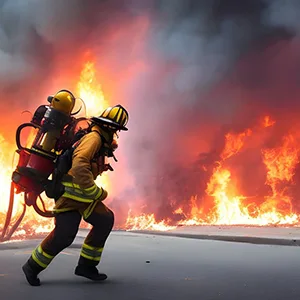A one-year Fireman course is typically designed to equip individuals with the necessary skills, knowledge, and physical fitness to serve as firefighters. The course generally combines theoretical learning with practical training to prepare students for the demanding nature of firefighting and emergency response work. Below is an outline of what such a course usually involves:
1. Course Duration:
- The course typically lasts one year, divided into multiple modules that include both theoretical instruction and hands-on practical experience.
2. Eligibility Criteria:
- Applicants should generally be at least 18 years old.
- A high school diploma or equivalent is often required.
- Good physical fitness is essential as firefighting is a physically demanding job.
3. Course Structure:
- Basic Firefighting Skills: Students learn how to extinguish fires, handle firefighting equipment, and ensure safety during fire emergencies.
- Fire Safety and Prevention: Education on fire safety practices, fire prevention, and risk assessment. Students also learn about fire hazards and the importance of safety codes.
- Rescue Operations: Training on rescue techniques, including rescue from burning buildings, rescue from heights, water rescues, and dealing with hazardous materials.
- Emergency Medical Care: Basic first aid and CPR are part of the course to equip students to assist in medical emergencies during firefighting operations.
- Hazardous Materials (HazMat) Handling: Training on how to respond to chemical spills, gas leaks, and other hazardous material incidents.
- Fire Behavior and Fire Chemistry: Understanding the science behind fire, including how fires start, spread, and can be extinguished.
- Search and Rescue Operations: Techniques for searching buildings and other structures for victims, ensuring safe evacuation, and dealing with injured individuals.
- Fire Equipment Handling: Hands-on training with firefighting tools and equipment such as hoses, fire trucks, breathing apparatus, and ladders.
- Fire Drill Simulations: Practical training involving mock fire scenarios, where students perform drills and respond to emergencies in controlled settings.
4. Physical Fitness Training:
- Physical fitness is a critical component of the course. Firefighters need to be in excellent physical condition to carry out their duties, including lifting heavy equipment, climbing ladders, and enduring physically strenuous situations.
- Regular fitness assessments are part of the curriculum, including strength, endurance, and agility exercises.
5. Internships and Practical Experience:
- Many courses offer internships or on-the-job training with fire departments, where students can apply their knowledge in real-world firefighting scenarios.
6. Certification and Examination:
- Upon successful completion of the course, students may be required to pass written and practical exams.
- They are typically awarded certifications such as a Firefighter I & II certification, which is recognized by national or regional fire safety bodies.
- Certification allows graduates to apply for firefighter positions with fire departments or emergency response teams.
7. Job Opportunities:
- Graduates can work as professional firefighters, emergency medical technicians (EMTs), fire inspectors, rescue specialists, or in other related emergency response roles.
- Firefighting also offers opportunities for career advancement, with experienced firefighters potentially moving into specialized roles like fire department officers, trainers, or investigators.
8. Career Skills Developed:
- Teamwork and Leadership: Firefighters often work in teams, and the course fosters collaborative work and leadership skills.
- Problem-solving: Firefighting requires quick thinking and decision-making in high-pressure situations.
- Communication: Firefighters need excellent communication skills to coordinate during emergencies and ensure clear instructions.
- Stress Management: Firefighters face highly stressful environments, and the course prepares individuals to handle stress and make sound decisions under pressure.
Conclusion:
A one-year Fireman course provides comprehensive training in firefighting, emergency rescue, medical aid, and fire safety. It prepares individuals physically and mentally to handle the challenging and critical tasks involved in protecting life and property during fires and emergencies.








Reviews
There are no reviews yet.